Module-2
Differential calculus-2
Taylor’s series-
If f(x + h) is a function of h which can be expanded in the ascending powers of h and is differentiable by any number of times with respect to h, then-
 + …….+
+ …….+  + ……..
+ ……..
Is called Taylor’s series.
If we put x = a, we get-
 + …….+
+ …….+  + …….. (1)
+ …….. (1)
Maclaurin’s Theorem-
If we put a = 0 and h = x then equation(1) becomes-
 + …….
+ …….
Which is called Maclaurin’s theorem.
Note – if we put h = x - a then there will be the expansion of F(x) in powers of (x – a)
We get-
 + …….
+ …….
Example-1: Express the polynomial  in powers of (x-2).
in powers of (x-2).
Sol. Here we have,
f(x) = 
Differentiating the function w.r.t.x-
f’(x) = 
f’’(x) = 12x + 14
f’’’(x) = 12
f’’’’(x)=0
Now using Taylor’s theorem-
 + ……. (1)
+ ……. (1)
Here we have, a = 2,
Put x = 2 in the derivatives of f(x), we get-
f(2) = 
f’(2) = 
f’’(2) = 12(2)+14 = 38
f’’’(2) = 12 and f’’’’(2) = 0
Now put a = 2 and substitute the above values in equation(1), we get-


Example-2: Expand  in powers of (x – 1).
in powers of (x – 1).
Sol.
Here we have-

Now-




Put these values in Taylor’s theorem-


We get-

Example-3: By using Maclaurin’s series expand tan x.
Sol.
Let-





Put these values in Maclaurin’s series we get-

Example-4: Expand  by using Maclaurin’s series.
by using Maclaurin’s series.
Sol.
Let





Put these values in Maclaurin’s series-

Or

Let we have two functions f(x) and g(x) and-

Then-

Is an expression of the form 
In that case we can say that f(x)/g(x) is an indeterminate for of the type  at x = a.
at x = a.
Now, Let we have two functions f(x) and g(x) and-

Then-

Is an expression of the form  , in that case we can say that f(x)/g(x) is an indeterminate for of the type
, in that case we can say that f(x)/g(x) is an indeterminate for of the type  at x = a.
at x = a.
Some other indeterminate forms are 
L’Hospital’s rule for  form-
form-
Working steps-
1. Check that the limits f(x)/g(x) is an indeterminate form of type  .
.
(Note- we can not apply L’Hospital rule if it is not in indeterminate form)
2. Differentiate f and g separately.
3. Find the limits of the derivatives .if the limit is finite , then it is equal to the limit of f(x)/g(x).
then it is equal to the limit of f(x)/g(x).
Example-1: Evaluate 
Sol. Here we notice that it is an indeterminate form of  .
.
So that , we can apply L’Hospital rule-

Example-2: Evaluate  .
.
Sol. Let f(x) =  and g(x) =
and g(x) =  .
.
Here we see that this is the indeterminate form of 0/0 at x = 0.
Now by using L’Hospital rule, we get-

= 
= 
=  = 1
= 1
Note- Suppose we get an indeterminate form even after finding first derivative, then in that case , we use the other form of L’Hospital’s rule.
If we have f(x) and g(x) are two functions such that 
 .
.
If  exist or (∞ , -∞), then
exist or (∞ , -∞), then

Example-3: Evaluate 
Sol. Let f(x) =  , then
, then

And
 = 0
= 0
 = 0
= 0
But if we use L’Hospital rule again, then we get-

Example-4: Evaluate 
Sol. We can see that this is an indeterminate form of type 0/0.
Apply L’Hospital’s rule, we get

But this is again an indeterminate form, so that we will again apply L’Hospital’s rule-
We get
 =
= 
L’Hospital’s rule for  form-
form-
Let f and g are two differentiable functions on an open interval containing x = a, except possibly at x = a and that

If  has a finite limit, or if it is
has a finite limit, or if it is  , then
, then

Theorem- If we have f(x) and g(x) are two functions such that  .
.
If  exist or (∞ , -∞), then
exist or (∞ , -∞), then

Example-5: Find  , n>0.
, n>0.
Sol. Let f(x) = log x and g(x) = 
These two functions satisfied the theorem that we have discussed above-
So that,

Example-6: Evaluate 
Sol. Apply L’Hospital rule as we can see that this is the form of 
 =
= 
Note- In some cases like above example, we can not apply L’Hospital’s rule.
Other types of indeterminate forms-
Example-7: Evaluate 
Sol. Here we find that-

So that this limit is the form of 0 .
.
Now,
Change  to obtain the limit-
to obtain the limit-

Now this is the form of 0/0,
Apply L’Hospital’s rule-

First order partial differentiation-
Let f(x, y) be a function of two variables. Then the partial derivative of this function with respect to x can be written as  and defined as follows:
and defined as follows:

Now the partial derivative of f with respect to f can be written as  and defined as follows:
and defined as follows:

Note: a. While calculating partial derivatives treat all independent variables, other than the variable with respect to which we are differentiating , as constant.
b. We apply all differentiation rules.
Higher order partial differentiation-
Let f(x , y) be a function of two variables. Then its second-order partial derivatives, third order partial derivatives and so on are referred as higher order partial derivatives.
These are second order four partial derivatives:
(a)  =
= 
(b)  =
= 
(c)  =
= 
(d)  =
= 
b and c are known as mixed partial derivatives.
Similarly we can find the other higher order derivatives.
Example-1: -Calculate  and
and  for the following function
for the following function
f(x , y) = 3x³-5y²+2xy-8x+4y-20
Sol. To calculate  treat the variable y as a constant, then differentiate f(x,y) with respect to x by using differentiation rules,
treat the variable y as a constant, then differentiate f(x,y) with respect to x by using differentiation rules,
 =
=  [3x³-5y²+2xy-8x+4y-20]
[3x³-5y²+2xy-8x+4y-20]
=  3x³] -
3x³] -  5y²] +
5y²] +  [2xy] -
[2xy] - 8x] +
8x] + 4y] -
4y] -  20]
20]
= 9x² - 0 + 2y – 8 + 0 – 0
= 9x² + 2y – 8
Similarly partial derivative of f(x,y) with respect to y is:
 =
=  [3x³-5y²+2xy-8x+4y-20]
[3x³-5y²+2xy-8x+4y-20]
=  3x³] -
3x³] -  5y²] +
5y²] +  [2xy] -
[2xy] - 8x] +
8x] + 4y] -
4y] -  20]
20]
= 0 – 10y + 2x – 0 + 4 – 0
= 2x – 10y +4.
Example-2: Calculate  and
and  for the following function
for the following function
f( x, y) = sin(y²x + 5x – 8)
Sol. To calculate  treat the variable y as a constant, then differentiate f(x,y) with respect to x by using differentiation rules,
treat the variable y as a constant, then differentiate f(x,y) with respect to x by using differentiation rules,
 [sin(y²x + 5x – 8)]
[sin(y²x + 5x – 8)]
= cos(y²x + 5x – 8) (y²x + 5x – 8)
(y²x + 5x – 8)
= (y² + 50)cos(y²x + 5x – 8)
Similarly partial derivative of f(x,y) with respect to y is,
 [sin(y²x + 5x – 8)]
[sin(y²x + 5x – 8)]
= cos(y²x + 5x – 8) (y²x + 5x – 8)
(y²x + 5x – 8)
= 2xy cos(y²x + 5x – 8)
Example-3: Obtain all the second order partial derivative of the function:
f( x, y) = ( x³y² - xy⁵)
Sol.
 3x²y² - y⁵,
3x²y² - y⁵,  2x³y – 5xy⁴,
2x³y – 5xy⁴,
 =
=  = 6xy²
= 6xy²
 =
=  2x³ - 20xy³
2x³ - 20xy³
 =
=  = 6x²y – 5y⁴
= 6x²y – 5y⁴
 =
=  = 6x²y - 5y⁴
= 6x²y - 5y⁴
Example-4: Find

Sol. First we will differentiate partially with repsect to r,


Now differentiate partially with respect to θ, we get


Example-5: if,

Then find.

Sol-
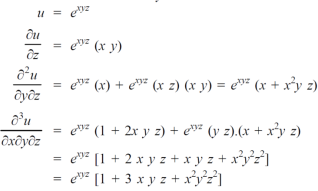
Example-6: if  , then show that-
, then show that- 
Sol. Here we have,
u =  …………………..(1)
…………………..(1)
Now partially differentiate eq.(1) w.r to x and y , we get

= 
Or
 ………………..(2)
………………..(2)
And now,

= 
 ………………….(3)
………………….(3)
Adding eq. (1) and (3) , we get

Hence proved.
Higher order partial derivatives-
When we differentiate a function depend on more than one independent variable, we differentiate it with respect to one variable keeping other as constant.
A second order partial derivative means differentiating twice
In general  are also function of x and y and so these can be further partially differentiated with respect to x and y.
are also function of x and y and so these can be further partially differentiated with respect to x and y.



In general 
Notation:
Generalization: If 
Then the partial derivative of z with respect to  is obtained by differentiating z with respect to
is obtained by differentiating z with respect to  treating all the other variables as constant and is denoted by
treating all the other variables as constant and is denoted by

Example1: If  . Then prove that
. Then prove that

Given 
Partially differentiating z with respect to x keeping y as constant


Again partially differentiating given z with respect to y keeping x as constant


On b.eq(i) +a.eq(ii) we get

Hence proved.
Example2 : If 
Show that 
Given 
Partially differentiating z with respect to x keeping y as constant

Again partially differentiating z with respect to x keeping y as constant


Partially differentiating z with respect to y keeping x as constant

Again partially differentiating z with respect to y keeping x as constant

From eq(i) and eq(ii) we conclude that

Example3 : Find the value of n so that the equation

Satisfies the relation 
Given 
Partially differentiating V with respect to r keeping  as constant
as constant

Again partially differentiating given V with respect to  keeping r as constant
keeping r as constant

Now, we are taking the given relation

Substituting values using eq(i) and eq(ii)









On solving we get 
Example 4 : If  then show that when
then show that when 

Given 
Taking log on both side we get

Partially differentiating with respect to x we get


 …..(i)
…..(i)
Similarly partially differentiating with respect y we get
 ……(ii)
……(ii)
LHS : 

Substituting value from (ii)


Again substituting value from (i) we get
 ]
]

When 





=RHS
Hence proved
Example5 :If 
Then show that 
Given 
Partially differentiating u with respect to x keeping y and z as constant

Similarly partially differentiating u with respect to y keeping x and z as constant
 …….(ii)
…….(ii)
Similarly partially differentiating u with respect to z keeping x and y as constant
 …….(iii)
…….(iii)
LHS: 






Hence proved
- Taylor’s series-
 + …….+
+ …….+  + ……..
+ ……..
2. Maclaurin’s Theorem-
 + …….
+ …….
When we measure the rate of change of the dependent variable owing to any change in a variable on which it depends, when none of the variable is assumed to be constant.
Let the function, u = f( x, y), such that x = g(t) , y = h(t)
ᵡ Then we can write,
 =
= 
= 
This is the total derivative of u with respect to t.
Change of variable-
If w = f (x, y) has continuous partial variables fxand fyand if x = x (t), y = y (t) are
Differentiable functions of t, then the composite function w = f (x (t), y (t)) is a
Differentiable function of t.
In this case, we get,
 fx(x (t), y (t)) x’(t)+ fy(x(t), y (t)) y’(t).
fx(x (t), y (t)) x’(t)+ fy(x(t), y (t)) y’(t).
Example-:1 let q = 4x + 3y and x = t³ + t² + 1 , y = t³ - t² - t
Then find  .
.
Sol. : . =
. = 
Where, f1 =  , f2 =
, f2 = 
In this example f1 = 4 , f2 = 3
Also,  3t² + 2t ,
3t² + 2t , 
 4(3t² + 2t) + 3(
4(3t² + 2t) + 3(
= 21t² + 2t – 3
Example-2: Find  if u = x³y⁴ where x = t³ and y = t².
if u = x³y⁴ where x = t³ and y = t².
Sol. As we know that by definition,  =
= 
 3x²y⁴3t² + 4x³y³2t = 17t¹⁶.
3x²y⁴3t² + 4x³y³2t = 17t¹⁶.
Example-3: if w = x² + y – z + sin t and x + y = t, find
(a)  y,z
y,z
(b)  t, z
t, z
Sol. With x, y, z independent, we have
t = x + y, w = x²+ y - z + sin (x + y).
Therefore,
 y,z = 2x + cos(x+y)
y,z = 2x + cos(x+y) (x+y)
(x+y)
= 2x + cos (x + y)
With x, t, z independent, we have
Y = t-x, w= x² + (t-x) + sin t
Thus t, z = 2x - 1
t, z = 2x - 1
Example-4: If u = u( y – z , z - x , x – y) then prove that  = 0
= 0
Sol. Let,

Then,


By adding all these equations we get,
 = 0 hence proved.
= 0 hence proved.
Example-5: if φ( cx – az , cy – bz) = 0 then show that ap + bq = c
Where p =  q =
q = 
Sol. We have,
φ( cx – az , cy – bz) = 0
φ( r , s) = 0
Where,

We know that,
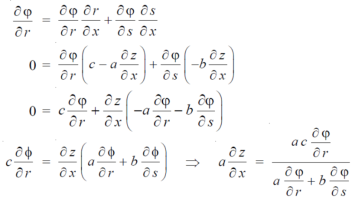
Again we do,
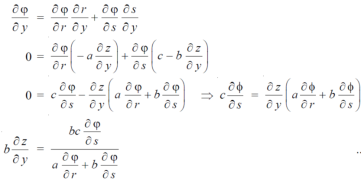
By adding the two results, we get


Example-6: If z is the function of x and y , and x =  , y =
, y =  , then prove that,
, then prove that,

Sol. Here , it is given that, z is the function of x and y & x , y are the functions of u and v.
So that,
 ……………….(1)
……………….(1)
And,
 ………………..(2)
………………..(2)
Also there is,
x =  and y =
and y =  ,
,
Now,
 ,
,  ,
,  ,
, 
From equation(1) , we get
 ……………….(3)
……………….(3)
And from eq. (2) , we get
 …………..(4)
…………..(4)
Subtracting eq. (4) from (3), we get
 =
=  )
) – (
– (
= x
Hence proved.
Derivatives of composite and implicit functions (Chain rule) -
A composite function is a composition / combination of the functions. In this value of one function depends on the value of another function. A composite function is created when one function is put in another.
Let 
i.e 
To differentiate composite function chain rule is used:
Chain rule:
- If
 where x,y,z are all the function of t then
where x,y,z are all the function of t then

2. If  be an implicit relation between x and y .
be an implicit relation between x and y .
Differentiating with respect to x we get

We get 
Example1 : If  where
where  then find the value of
then find the value of  ?
?
Given 
Where 
By chain rule




Now substituting the value of x ,y,z we get
 -6
-6

 8
8
Example2: If  then calculate
then calculate 
Given 
By Chain Rule




Putting the value of u = 

Again partially differentiating z with respect to y
By Chain Rule



 by substituting value
by substituting value 

Example 3 :If  .
.
Show that 
Given 
Partially differentiating u with respect to x and using chain rule


 ………(i)
………(i)
Partially differentiating z with respect to y and using chain rule


=  ………..(ii)
………..(ii)
Partially differentiating z with respect to t and using chain rule


Using (i) and (ii) we get

Hence-

Example4 : If  where the relation is
where the relation is  .
.
Find the value of 
Let the given relation is denoted by 
We know that 
Differentiating u with respect to x and using chain rule



Example5 : If  and the relation is
and the relation is  . Find
. Find 
Given relation can be rewrite as
 .
.
We know that

Differentiating u with respect to x and using chain rule



Implicit differentiation-
Let f(x,y) = 0
Where y = ∅(x)
By the chain rule , with x = x and y = ∅(x), we get


Here we assume that y is a differentiable funtion of x.
Example-1: if ∅ is a differentiable function such that y = ∅(x) satisfies the equation
x³ + y³ +sin xy = 0 then find  .
.
Sol. Suppose f(x,y) = x³ + y³ +sin xy
Then ,
fᵡ = 3x² + y cos xy
Fy = 2y + x cos xy
So ,

Example-2: Let 
Sol. Take partial derivative on both side w.r. t. x , treat y as constant





Example-3: if x²y³ + cos y cos z = x² cos x sin y, then find 
Sol. Differentiate partially w.r.t. x and treat y as constant,

If f(x) is a single valued function defined in a region R then
Maxima is a maximum point  if and only if
if and only if 
Minima is a minimum point  if and only if
if and only if 
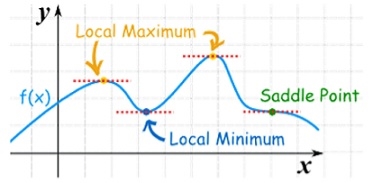


Maxima and Minima of a function of two independent variables
Let  be a defined function of two independent variables.
be a defined function of two independent variables.
Then the point  is said to be a maximum point of
is said to be a maximum point of  if
if

Or  =
= 
For all positive and negative values of h and k.
Similarly the point  is said to be a minimum point of
is said to be a minimum point of  if
if

Or  =
= 
For all positive and negative values of h and k.
Saddle point:
Critical points of a function of two variables are those points at which both partial derivatives of the function are zero. A critical point of a function of a single variable is either a local maximum, a local minimum, or neither. With functions of two variables there is a fourth possibility - a saddle point.
A point is a saddle point of a function of two variables if
![2 2 [ 2 ] 2
@f-= 0, @f--= 0, and @-f- @-f-- -@-f- < 0
@x @y @x2 @y2 @x @y](https://glossaread-contain.s3.ap-south-1.amazonaws.com/epub/1643008901_35557.png)
At the point.
Stationary Value
The value  is said to be a stationary value of
is said to be a stationary value of  if
if

i.e. the function is a stationary at (a , b).
Rule to find the maximum and minimum values of 
- Calculate
 .
. - Form and solve
 , we get the value of x and y let it be pairs of values
, we get the value of x and y let it be pairs of values 
- Calculate the following values :

4. (a) If 
(b) If 
(c) If 
(d) If 
Example-1: Find out the maxima and minima of the function

Sol.
Given
 …(i)
…(i)
Partially differentiating (i) with respect to x we get
 ….(ii)
….(ii)
Partially differentiating (i) with respect to y we get
 ….(iii)
….(iii)
Now, form the equations 
Using (ii) and (iii) we get


 using above two equations
using above two equations
Squaring both side we get

Or 
This show that 
Also we get 
Thus we get the pair of value as 
Now, we calculate



Putting above values in

At point (0,0) we get

So, the point (0,0) is a saddle point.
At point  we get
we get

So the point  is the minimum point where
is the minimum point where 
In case 

So the point  is the maximum point where
is the maximum point where 
Example2 Find the maximum and minimum point of the function

Partially differentiating given equation with respect to and x and y then equate them to zero


On solving above we get 
Also 
Thus we get the pair of values (0,0), ( ,0) and (0,
,0) and (0,
Now, we calculate



At the point (0,0)

So function has saddle point at (0,0).
At the point (

So the function has maxima at this point ( .
.
At the point (0,

So the function has minima at this point (0, .
.
At the point (

So the function has an saddle point at (
Example-3: There is rectangular box which is open at the top, is to have a volume of 32 c.c.
Find the dimensions of the box requiring least (minimum) material to construct it.
Sol. Here it is given that-
Volume (V) = 32 c.c.
Suppose ‘l’ , ‘b’, ‘h’ are the length, breadth, height of the rectangular box respectively and its surface area is ‘S’.
As we know that-
Volume (V) = l b h = 32
b (breadth) = 32/lh
And the surface area of the rectangular box which is open at the top is-
S = 2 (l + b) h + l b …………… (1)
On putting the value of ‘b’ in (1), we get-
S = 2 
S =  ……………… (2)
……………… (2)
Differentiate partially equation (2) with respect to l and h respectively, we get-
 …………… (3) and
…………… (3) and …………….. (4)
…………….. (4)
For Max. And Min. S, we get-

And 
The values of ‘l’, ‘h’ and ‘b’ will be-
L = 4, h = 2 and b = 4
Now-


And


So that-
 , then S is minimum for l = 4, b = 4, and h = 2
, then S is minimum for l = 4, b = 4, and h = 2
Key takeaways-
- A point is a saddle point of a function of two variables if
![2 2 [ 2 ] 2
@f-= 0, @f--= 0, and @-f- @-f-- -@-f- < 0
@x @y @x2 @y2 @x @y](https://glossaread-contain.s3.ap-south-1.amazonaws.com/epub/1643008905_1807072.png)
At the point.
2. The value  is said to be a stationary value of
is said to be a stationary value of  if
if

Suppose  is a function of three independent variables, where x,y,z are related to a constraint
is a function of three independent variables, where x,y,z are related to a constraint
 (x, y, z) = 0 …………………… (1)
(x, y, z) = 0 …………………… (1)
So that for stationary values-
 ,
,  ,
, 
 ………………….. (2)
………………….. (2)
By total differentiation of (1), we get-
 …………………… (3)
…………………… (3)
Now multiply by  and adding to (2), we get-
and adding to (2), we get-


That equation holds good if-



We can find the values of x, y, z and  by solving these equations.
by solving these equations.
Example-1: Determine the maxima and minima of  when
when  1
1
Sol. Suppose  ……….. (1)
……….. (1)
And  =0 …………… (2)
=0 …………… (2)
Differentiate partially equation (1) and (2) w.r.t. x and y respectively, we get-

And 
Now using Lagrange’s equations, we get-

Which gives-
 or
or ……… (3)
……… (3)

Which gives-
 …… (4)
…… (4)

Which gives-
 ……. (5)
……. (5)
Multiply these equations by x, y, z respectively and adding, we get-

(
Hence we get-
f +  0 then
0 then 
Put in (3) , (4) and (5), we get-
in (3) , (4) and (5), we get-
x(1 – fa) = 0 , y(1 – fb) = 0 and z(1 – fc) = 0
We get-

These gives the maximum and minimum values of f.
Example: Decampere a positive number ‘a’ in to three parts, so their product is maximum
Solution:
Let x, y, z be the three parts of ‘a’ then we get.
 … (1)
… (1)
Here we have to maximize the product
i.e. 
 By Lagrange’s undetermined multiplier, we get,
By Lagrange’s undetermined multiplier, we get,

 … (2)
… (2)
 … (3)
… (3)
 … (4)
… (4)
i.e.
 … (2)’
… (2)’
 … (3)’
… (3)’
 … (4)
… (4)



And 


From (1)



Thus  .
.
Hence their maximum product is  .
.
Example: Find the point on plane  nearest to the point (1, 1, 1) using Lagrange’s method of multipliers.
nearest to the point (1, 1, 1) using Lagrange’s method of multipliers.
Solution:
Let  be the point on sphere
be the point on sphere  which is nearest to the point
which is nearest to the point  . Then shortest distance.
. Then shortest distance.


 Let
Let 
Under the condition  … (1)
… (1)
 By method of Lagrange’s undetermined multipliers we have
By method of Lagrange’s undetermined multipliers we have

 … (2)
… (2)

 … (3)
… (3)
i.e.  &
&

 … (4)
… (4)
From (2) we get 
From (3) we get 
From (4) we get 
 Equation (1) becomes
Equation (1) becomes

i.e. 




y = 2

Maxima and minima of function of two variables and three variables using method of Lagrange’s multiplier-
Generally we calculate the stationary value of a function with some relation by converting the given function into the least possible independent variables and then solve them.
When this method fails we use Lagrange’s method.
This method is used to calculate the stationary value of a function of several variables which are all not independent but are connected by some relation.
Let  be the function in the variable x, y and z which is connected by the relation
be the function in the variable x, y and z which is connected by the relation 
Rule: a) Form the equation

Where  is a parameter.
is a parameter.
b) Form the equation using partial differentiation is

(We always try to eliminate )
)
c) Solve the all above equation with the given relation 
These give the value of 
These value obtained when substituted in the given function will give the stationary value of the function.
Example1 Divide 24 into three parts such that the continued product of the first, square of second and cube of third may be maximum.
Let first number be x, second be y and third be z.
According to the question
Let the given function be f
And the relation 
By Lagrange’s Method

 ….(i)
….(i)
Partially differentiating (i) with respect to x,y and z and equate them to zero
 ….(ii)
….(ii)
 ….(iii)
….(iii)
 ….(iv)
….(iv)
From (ii),(iii) and (iv) we get

On solving

Putting it in given relation we get

Or 
Or 
Thus the first number is 4 second is 8 and third is 12
Example2-The temperature T at any point  in space is
in space is  .Find the highest temperature on the surface of the unit sphere.
.Find the highest temperature on the surface of the unit sphere.
Given function is 
On the surface of unit sphere given  [
[ is an equation of unit sphere in 3 dimensional space]
is an equation of unit sphere in 3 dimensional space]
By Lagrange’s Method

 ….(i)
….(i)
Partially differentiating (i) with respect to x, y and z and equate them to zero
 or
or …(ii)
…(ii)
 or
or …(iii)
…(iii)
 …(iv)
…(iv)
Dividing (ii) and (ii) by (iv) we get

Using given relation 
Or  Or
Or 
So that 
Or 
Thus points are 
The maximum temperature is 
Example3 If ,Find the value of x and y for which
,Find the value of x and y for which  is maximum.
is maximum.
Given function is 
And relation is 
By Lagrange’s Method

 [
[ ] ..(i)
] ..(i)
Partially differentiating (i) with respect to x, y and z and equate them tozero

Or  …(ii)
…(ii)

Or  …(iii)
…(iii)

Or  …(iv)
…(iv)
On solving (ii),(iii) and (iv) we get


Using the given relation we get 



So that 
Thus the point for the maximum value of the given function is 
Example-4: Find the points on the surface  nearest to the origin.
nearest to the origin.
Let  be any point on the surface, then its distance from the origin
be any point on the surface, then its distance from the origin  is
is

Thus the given equation will be

And relation is 
By Lagrange’s Method

 ….(i)
….(i)
Partially differentiatig (i) with respect to x, y and z and equate them to zero

Or  …(ii)
…(ii)

Or  …(iii)
…(iii)

Or 
Or 
On solving equation (ii) by (iii) we get

And 
On subtracting we get
Putting in above 
 Or
Or 
Thus 
Using the given relation we get
 = 0.0 +1=1
= 0.0 +1=1
Or 
Thus point on the surface nearest to the origin is 
We use the concept of maxima and minima to find the maximum and minimum value of the function.
Example: Find the volume of the greatest rectangular parallelepiped that can be inscribed in the ellipsoid-

Sol.
Suppose the edges of the parallelepiped are 2x, 2y, 2z and these are parallel to the axes
Then we know that the volume will be-
V = 8xyz
Here we need to find out the maximum value of V with the given conditions-

Write-

Then

And

And

From equation (1) and (2), equate the value of  , we get-
, we get-

Similarly from (2) and (3), we get-

We can say that

Put these values in equation (A),
We get-

Which means-

Which gives-

When x = 0, the parallelepiped is a rectangular sheet and its volume V = 0.
As x increases, V also increases.
So that V must be maximum (stage given by eq-4)
Hence the greatest (Maximum) volume is-

Example: Show that the rectangular solid of maximum volume that can be inscribed in a sphere is a cube.
Sol.
Suppose 2x, 2y, 2z are the length, breadth and height of the rectangular solid.
Its volume will be-
V = 8xyz ....... (1)
And let R is the radius of the sphere so that-

Then

Now


Or

So that for a maximum value x = y = z
Now we can say that the rectangular solid of maximum volume that can be inscribed in a sphere is a cube.
Example-2: Find the minimum distance from the point (1, 2, 0) to the cone 
Sol. Let there are three points (x, y, z) on the cone then the distance from the point (1, 2, 0) by using distance formula will be-

Suppose  ………….. (1)
………….. (1)
Subject to  ………………. (2)
………………. (2)
From equation (1) and (2), for minimum, we get-
 ………….. (3)
………….. (3)
 ……………. (4)
……………. (4)
Multiply (4) by  and adding in (3), we get-
and adding in (3), we get-


 ,
,  ,
, 
We get-

We get the values of x and y-
x = 1/2 , y = 1
Put the values of x and y in equation (2), we get-



So that the min. Distance form the point (1, 2, 0) is-

Therefore,

 Ans.
Ans.
If u and v are functions of the two independent variables x and y , then the determinant,

Is known as the jacobian of u and v with respect to x and y, and it can be written as,

Suppose there are three functions u , v and w of three independent variables x , y and z then,
The Jacobian can be defined as,
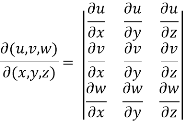
Important properties of the Jacobians-
Property-1-
If u and v are the functions of x and y , then

Proof- Suppose u = u(x,y) and v = v(x,y) , so that u and v are the functions of x and y,
Now,

Interchange the rows and columns of the second determinant, we get


Differentiate u = u(x,y) and v= v(x,y) partially w.r.t. u and v, we get




Putting these values in eq.(1) , we get
 hence proved.
hence proved.
Property-2:
Suppose u and v are the functions of r and s, where r,s are the fuctions of x , y, then,

Proof:  =
= 
Interchange the rows and columns in second determinant
We get,
= 
= 
=  =
= 
Similarly we can prove for three variables.
Property-3
If u,v,w are the functions of three independent variables x,y,z are not independent , then,

Proof: here u,v,w are independent , then f(u,v,w) = 0 ……………….(1)
Differentiate (1), w.r.t. x, y and z , we get
 …………(2)
…………(2)
 ………………(3)
………………(3)
 ………………..(4)
………………..(4)
Eliminate  from 2,3,4 , we get
from 2,3,4 , we get

Interchanging rows and columns , we get
 = 0
= 0
So that,

Example-1: If x = r sin , y = r sin
, y = r sin , z = r cos
, z = r cos , then show that
, then show that
 sin
sin also find
also find 
Sol. We know that,

= 
= 
=  ( on solving the determinant)
( on solving the determinant)
= 
Now using first propert of Jacobians, we get

Example-2: If u = x + y + z ,uv = y + z , uvw = z , find 
Sol. Here we have,
x = u – uv = u(1-v)
y = uv – uvw = uv( 1- w)
And z = uvw
So that,

=
Apply 
=
Now we get,
= u²v(1-w) + u²vw
= u²v
Example-3: If u = xyz , v = x² + y² + z² and w = x + y + z, then find J = 
Sol. Here u ,v and w are explicitly given , so that first we calculate

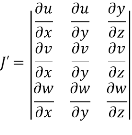

= yz(2y-2z) – zx(2x – 2z) + xy (2x – 2y)
= 2[yz(y-z)-zx(x-z)+xy(x-y)]
= 2[x²y - x²z - xy² + xz² + y²z - yz²]
= 2[x²(y-z) - x(y² - z²) + yz (y – z)]
= 2(y – z)(z – x)(y – x)
= -2(x – y)(y – z)(z – x)
By the property,
JJ’ = 1

Jacobian of Implicit functions-
If the variables u,v, x, and y are connected by the following equations-
 ………………… (1)
………………… (1)
 ………………….. (2)
………………….. (2)
u,v are the implicit functions of x and y.
Now differentiate equation (1) and (2) with respect to x and y-
 ………… (3)
………… (3)
 ……………… (4)
……………… (4)
 ………………. (5)
………………. (5)
 ………………. (6)
………………. (6)
Now,
 =
= 
Using equation (3), (4), (5), (6), we get-
= 
So that-


We can find this for three variables as well.
Example-1: If u = 2axy, v =  then prove that-
then prove that-

Sol. Here we have,
u = 2axy, v = 
Then

Here - 
So that

Now,

Hence-

Hence proved.
Example-2: If  , then prove that-
, then prove that-

Sol. Suppose 
And 
Now

And

So that,

Hence proved.
Example-3: If x + y + z = u, y + z = uv , z = uvw, then prove that-

Sol. Suppose



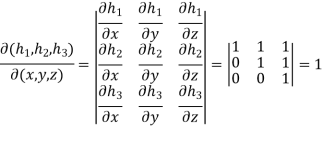
And

Hence,

Hence proved.
Jacobians for functional dependence functions-
Note- two functions u and v said to be functionally dependent if their jacobian is equals to zero. That means J (u , v) = 0
Suppose u and v are functionally dependent functions, then
f( u, v) = 0
Differentiate this equation with respect to x and y-
 = 0
= 0
 = 0
= 0
There will be a non-trivial solution for  ,
,  to this system exists.
to this system exists.
So that-

On transposing, we get-


Example-1: Show that  and
and  are functionally dependent.
are functionally dependent.
Sol. Here we have-
 and
and
Now we will find out the Jacobian to check the functional dependence.

= 
Here Jacobian is zero, so we can conclude that these functions are functionally dependent.
Example-2: Prove that u, v, w are functionally dependent, where-

Sol. Here we have

Now we will find out the Jacobian of the given functions-

= 
= 
= 0
Therefore, u, v, w are functionally dependent.
Key takeaways-
- If u and v are functions of the two independent variables x and y , then the determinant,

Is known as the jacobian of u and v with respect to x and y, and it can be written as,

2. If u and v are the functions of x and y , then

3. Suppose u and v are the functions of r and s, where r,s are the fuctions of x , y, then,

4. If u,v,w are the functions of three independent variables x,y,z are not independent , then,

References:
- C.Ray Wylie, Louis C.Barrett : "Advanced Engineering Mathematics", 6th Edition, 2. McGraw-Hill Book Co., New York, 1995.
- James Stewart : “Calculus -Early Transcendentals”, Cengage Learning India Private Ltd., 2017.
- B.V.Ramana: "Higher Engineering Mathematics" 11th Edition, Tata McGraw-Hill, 2010.
- Srimanta Pal & Subobh C Bhunia: “Engineering Mathematics”, Oxford University Press, 3rd Reprint, 2016.
- Gupta C.B., Singh S.R. And Mukesh Kumar: “Engineering Mathematics for Semester I & II”, Mc-Graw Hill Education (India) Pvt.Ltd., 2015.




